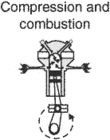Otto cycle
[′äd·ō ‚sī·kəl]Otto cycle
The basic thermodynamic cycle for the prevalent automotive type of internal combustion engine. The engine uses a volatile liquid fuel (gasoline) or a gaseous fuel to carry out the theoretic cycle shown in the illustration. The cycle consists of two isentropic (reversible adiabatic) phases interspersed between two constant-volume phases. The theoretic cycle should not be confused with the actual engine built for such service as automobiles, motor boats, aircraft, lawn mowers, and other small self-contained power plants.
The thermodynamic working fluid in the cycle is subjected to isentropic compression, phase 1–2; constant-volume heat addition, phase 2–3; isentropic expansion, phase 3–4; and constant-volume heat rejection (cooling), phase 4–1.
The Otto cycle is represented in many millions of engines utilizing either the four-stroke principle or the two-stroke principle. Evidence indicates that actual Otto engines offer peak efficiencies (25±%) at compression ratios of 15±. Above this ratio, efficiency falls. The most probable explanation is that the extreme pressures associated with high compression cause increasing amounts of dissociation of the combustion products. This dissociation, near the beginning of the expansion stroke, exerts a more deleterious effect on efficiency than the corresponding gain from increasing compression ratio. See Brayton cycle, Carnot cycle, Internal combustion engine, Thermodynamic cycle
Otto cycle




